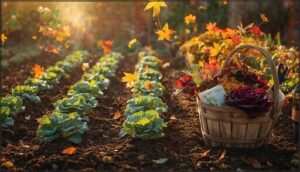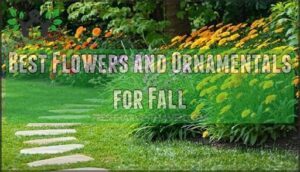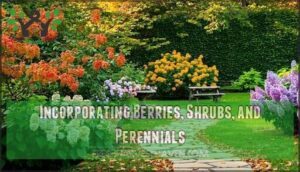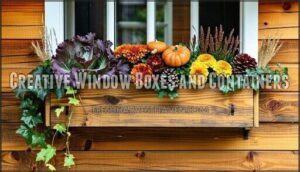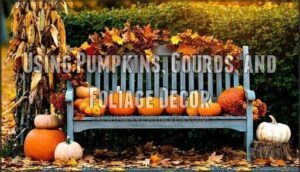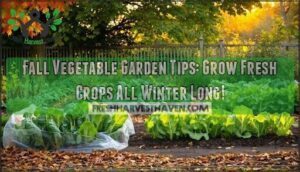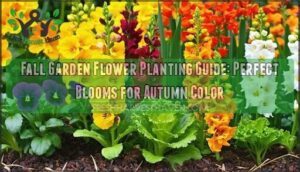This site is supported by our readers. We may earn a commission, at no cost to you, if you purchase through links.

Fall’s perfect for establishing spring bulbs, mums, and ornamental grasses that’ll give you months of color. Count backward from your first frost date and add two weeks as a safety buffer when timing plantings. The trick is working with fall’s natural rhythm instead of fighting summer’s heat.
Smart gardeners know there’s more to maximizing this golden window than just tossing seeds in the ground.
Table Of Contents
- Key Takeaways
- Key Dates and Facts for Autumn Gardening
- Planning Your Autumn Vegetable Garden
- Best Flowers and Ornamentals for Fall
- Designing a Vibrant Fall Landscape
- Essential Fall Gardening Tips and Maintenance
- Frequently Asked Questions (FAQs)
- Can you plant a garden in the autumn?
- What are the best Fall Garden ideas?
- What flowers can you plant in a fall garden?
- How can I create a beautiful fall garden?
- How do you dress up a garden for fall?
- What plants are autumnal?
- What plants are best to plant in autumn?
- What can you plant in the fall in a garden?
- When should I start my fall garden?
- What grows fastest in autumn?
- Conclusion
Key Takeaways
- Time your plantings around your first frost date – Count backward from your area’s average first frost, add 2 weeks’ buffer time, and plant cool-season crops like kale, spinach, and carrots between mid-August and September.
- Focus on cool-season vegetables that improve with cold weather – These crops actually develop sweeter flavors after a light frost hits, making fall the ideal time to grow leafy greens and root vegetables.
- Plant spring bulbs and fall-blooming flowers now – Establish tulips, daffodils, mums, and ornamental grasses during fall’s golden window when the soil stays warm but air temperatures cool.
- Prepare your soil and protect plants from early frost – Use shade cloth and mulching to cool the soil for new plantings, then switch to row covers and frost blankets when temperatures drop below 40°F.
Key Dates and Facts for Autumn Gardening
Successful fall gardening starts with knowing the right timing and understanding seasonal changes. The first day of fall 2025 arrives on September 22nd at the autumnal equinox, when day and night are nearly equal, marking the perfect time to plan your autumn planting schedule around your area’s specific frost dates.
When is The First Day of Fall 2025?
The First Day of Fall 2025 arrives Monday, September 22, marking the official Autumnal Equinox date according to the Astronomical Calendar. This year’s Fall Equinox occurs during an ideal time for Fall Garden Planning, as it’s the moment when the Sun crosses the Equator.
The seasonal shift brings perfect Solar Cycles for autumn planting, with September 22 offering gardeners the golden opportunity to begin their fall planting schedules. These Autumnal Dates signal cooler temperatures ahead—nature’s green light for your seasonal garden projects.
Gardeners can learn more about the autumn equinox to plan their fall planting effectively.
What is The Autumnal Equinox?
The Autumnal Equinox marks a pivotal moment in Solar Cycles when Earth’s Axis creates perfect balance between day and night. This Fall Equinox occurs on September 22, 2025, ushering in the Autumn Season with this astronomical Seasonal Shift:
- Equinox Meaning: Equal hours of daylight and darkness worldwide
- Celestial mechanics: Sun crosses the celestial equator southward
- Autumnal History: Ancient cultures celebrated this harvest transformation
- Harvest Moon connection: Full moon nearest the equinox aids evening harvests
The Autumnal Equinox is also a key moment to check the almanac fall dates to plan seasonal activities.
Understanding Frost Dates and Timing
Most gardeners need their frost date as their North Star for Fall Planting success. Your area’s average first frost typically arrives between late September and mid-November, depending on your zone.
Weather Forecasting helps, but Cold Hardiness varies by crop. Cool Season Crops like kale tolerate light frost, while tender plants don’t.
Count backwards from your Frost Date, adding two weeks buffer time for Timing Strategies. Late Season Sowing works when you pick shorter-maturity varieties. Seasonal shifts happen fast, so Frost Date Planning and Frost Prediction become essential tools for maximizing your harvest window. Understanding the fall planting calendar is vital for determining the best time to plant cool-season crops.
Planning Your Autumn Vegetable Garden
You’ll find that planning your autumn vegetable garden requires timing your plantings based on your first frost date and choosing crops that thrive in cooler temperatures.
Cool-season vegetables like kale, carrots, and broccoli actually develop better flavors when grown in fall’s crisp conditions, which makes cool-season vegetables a great choice.
Choosing Cool-Season Crops
Cool season crops thrive when temperatures drop below 21°C, making fall planting perfect timing. Smart vegetable selection focuses on leafy greens like spinach, kale, and lettuce that tolerate frost.
Root vegetables including carrots and radishes develop sweeter flavors in cool weather. Your fall garden plan should include crop rotation strategies and garden mapping to maximize space and extend your fall harvest season.
Fall’s crisp temperatures unlock the sweetest flavors in leafy greens and root vegetables
Fall Vegetable Planting Schedules
Timing matters more than you think when fall planting vegetables. August through September offers your prime planting window for most cool-season crops. Count backward from your area’s first frost date, adding crop maturity days plus two weeks buffer time.
Regional planting guides help you nail these dates perfectly. Start beets and carrots August 1-15, then broccoli and cabbage mid-August through mid-September for successful fall harvesting success. Understanding fall planting calendars is essential for planning a successful autumn garden.
Soil Preparation and Cooling Tips
Most fall vegetable gardens start with soil temperature above 80°F, which stresses cool-season crops. You’ll need cooling methods like shade cloth, frequent watering, and mulch application to drop temperatures. Moisture control becomes essential—keep soil consistently damp but not waterlogged.
Smart mulch application around seedlings regulates temperature while conserving water. These fall gardening tasks prepare your vegetable gardening space for successful fall planting. Effective use of shade cloth materials can substantially improve soil cooling and reduce stress on plants, which is a key part of fall gardening tasks.
Protecting Plants From Early Frost
Early frost can sneak up on your cool-season vegetables, but simple Frost Protection Methods will keep your fall garden thriving. Row Covers and proper timing before your frost date make all the difference for cool-weather crops.
- Cover plants when temperatures drop below 40°F – Use frost blankets, bed sheets, or row covers to trap soil heat overnight
- Water soil before expected frost – Moist ground retains more heat than dry soil, protecting root zones from freeze damage
- Apply Winter Mulching around plant bases – Straw, compost, or dead leaves insulate roots and prevent frost penetration
- Consider Cold Frame Gardening for extended harvests – These structures maintain warmer temperatures and extend your growing season by weeks
Freeze Damage Prevention starts with watching weather forecasts and having materials ready, including frost blanket options. Your Vegetable Gardening success depends on quick action when cold threatens.
Best Flowers and Ornamentals for Fall
Fall flowers transform your garden into a stunning display when summer blooms fade.
You can create lasting color with hardy ornamentals like mums, asters, and ornamental grasses that thrive in cooler temperatures.
Planting Mums, Asters, and Black-Eyed Susans
Plant mums six weeks before frost for strong roots. These Fall Blooming Perennials need six hours of sunlight and well-drained soil. Space mums and black-eyed susans 18 inches apart to prevent disease.
Asters require four hours of sun minimum. Their vibrant Garden Colors create stunning Flower Arrangements when other blooms fade. Choose diverse Mum Varieties for extended displays.
Follow proper Aster Planting techniques with ground-level watering for Susan Care. These Fall Garden Ideas transform landscapes into autumn showcases.
Growing Ornamental Grasses and Sedum
Ornamental grasses like fountain grass and feather reed grass create stunning Fall Garden Design backdrops. These Ornamental Plants require minimal Ornamental Grass Care—simply cut back in late winter.
Sedum Varieties such as ‘Autumn Joy’ offer spectacular Fall Blooming Perennials with pink-to-rust flowers. Both thrive in poor soil and drought conditions. Sedum Propagation happens easily through division. Together, they form the backbone of effective Grass Landscaping and Seasonal Gardening schemes.
Adding Dahlias, Coral Bells, and Fall Bulbs
Several stunning perennials deserve your attention this season. Dahlias provide spectacular blooms until frost, requiring proper dahlia care including weekly watering and deadheading.
Coral bell landscaping adds year-round foliage interest with colorful leaves ranging from burgundy to chartreuse. For spring anticipation, focus on fall bulb planting now—tulips, daffodils, and crocuses need cold treatment.
These choices create dynamic garden color schemes and support beautiful flower arrangements while enhancing your fall landscape design through thoughtful garden planning tips.
Designing a Vibrant Fall Landscape
Creating a stunning fall landscape starts with layering berry-producing shrubs, colorful perennials, and ornamental grasses that’ll keep your garden interesting long after summer flowers fade.
You can transform ordinary spaces into seasonal showstoppers by mixing creative containers filled with mums and trailing ivy alongside natural elements like decorative gourds and richly colored autumn foliage.
Incorporating Berries, Shrubs, and Perennials
Transform your fall garden into a wildlife haven by choosing berry shrubs like winterberry and beautyberry for Garden Texture and Fall Color. These Berry Selection choices support birds while creating stunning visual interest.
Pair drought-tolerant Perennial Choices like coneflower with deciduous Shrub Care favorites such as lilacs for effective Fall Landscape Design. Your Garden Planning Tips should include six weeks before frost for proper root establishment in your Fall Garden.
Creative Window Boxes and Containers
Why settle for boring containers when fall’s palette offers endless creative possibilities? Window boxes and hanging baskets become stunning focal points with the right seasonal arrangements.
- Layer textures with ornamental kale, trailing ivy, and compact mums for visual depth
- Mix heights using tall grasses, medium flowers, and cascading plants in container garden ideas
- Choose durable materials like cedar or resin planters that withstand temperature changes
- Add seasonal accents with mini pumpkins, pinecones, or decorative branches for fall planters
- Consider drainage by adding gravel layers and selecting appropriate potting mix for container gardening tips
Using Pumpkins, Gourds, and Foliage Decor
Pumpkins and gourds aren’t just for carving—they’re natural showstoppers in Fall Gardening Ideas. Stack different sizes for dynamic Harvest Displays, or scatter mini varieties among foliage garland. Create stunning Fall Centerpieces by pairing ornamental gourds with dried flower arrangements.
Corn stalks add height and rustic charm. These Seasonal Decor elements transform ordinary spaces into autumn wonderlands through simple Pumpkin Arrangements and creative Gourd Crafts. Effective fall garden design techniques can enhance the overall aesthetic of your outdoor space.
Essential Fall Gardening Tips and Maintenance
Successfully completing your fall garden means maintaining healthy soil and properly caring for your plants as temperatures drop.
You’ll need to focus on mulching, adjusting watering schedules, and preparing your garden tools for the colder months ahead.
Mulching and Composting for Soil Health
Smart gardeners know that autumn’s foundation lies in soil health. Fall’s cooler temperatures create perfect conditions for building nutrient-rich soil through mulching and composting strategies.
Fall’s cool air transforms your garden into nature’s perfect soil-building workshop
Here’s how to maximize your fall garden’s soil potential:
- Apply 2-4 inch organic mulch layers – conserves 20-30% more soil moisture through winter
- Blend chopped autumn leaves with green waste – creates balanced compost that decomposes 25-50% faster
- Cover compost piles with tarps – maintains ideal 40-60% moisture for active microbial breakdown
- Incorporate mature compost before winter – adds up to 2.5% stable organic matter to garden beds
These soil amendments boost microbial activity by 20-55% within six months. Proper mulch types like shredded leaves and straw gradually break down, improving carbon sequestration while supporting your fall vegetable gardening efforts. Smart garden care maintenance now means healthier spring seedling emergence rates increase by 15%. Understanding fall garden cleanup techniques is vital for maintaining a healthy and thriving garden ecosystem.
Watering and Plant Care in Cooler Weather
Watering your fall garden requires less water than summer gardens since cooler temperatures reduce evaporation. Check soil moisture regularly by inserting your finger two inches deep.
Water deeply but less frequently to encourage strong root development.
Focus on newly planted crops and established plants preparing for winter. Monitor weather forecasts for frost protection needs and adjust your watering schedule accordingly.
Pruning, Tool Care, and Winter Prep
Clean your pruners between cuts and sharpen all blades before winter storage. Focus fall pruning timing on dead branches only—save major cuts for late winter when plants heal better.
Apply winter mulching after first frost to protect soil.
Complete garden cleanup by removing debris that harbors pests.
Proper equipment storage in dry areas prevents rust and helps tools stay sharp for spring gardening tasks. Consider investing in high quality shears for superior pruning, which can aid in cleaning your pruners, focus fall pruning timing, and ultimately proper equipment storage.
Frequently Asked Questions (FAQs)
Can you plant a garden in the autumn?
Like paging through a Farmers’ Almanac from yesteryear, you’ll discover autumn’s perfect for planting cool-season crops.
Plant kale, spinach, radishes, and carrots now—they’ll thrive in cooler temperatures and provide fresh harvests through winter.
What are the best Fall Garden ideas?
You’ll love planting cool-season vegetables like kale, spinach, and carrots that actually taste sweeter after frost. Add fall mums, ornamental grasses, and spring bulbs for year-round garden magic.
What flowers can you plant in a fall garden?
Fall’s floral symphony can absolutely transform your garden into a breathtaking masterpiece! Plant chrysanthemums, asters, and ornamental kale for vibrant colors.
You’ll love fall-blooming anemones, sedum, and pansies that thrive in cooler weather, creating stunning displays.
How can I create a beautiful fall garden?
You’ll create stunning fall beauty by planting mums, ornamental grasses, and berry-producing shrubs. Add spring bulbs now for next year’s blooms.
Include kale, broccoli, and colorful vegetables for both aesthetics and harvest, which can also contribute to creating stunning fall beauty.
How do you dress up a garden for fall?
Add fall-blooming mums, ornamental grasses, and colorful berry-producing shrubs to your garden beds.
Plant spring bulbs now for next year’s early color, and incorporate seasonal foliage plants like sedum for autumn interest.
What plants are autumnal?
You’ll find plenty of autumnal plants that embrace the season’s charm. Mums, ornamental kale, asters, and pansies bloom beautifully in cooler weather, while ornamental grasses add texture and movement to your fall landscape displays.
What plants are best to plant in autumn?
You’ll want to plant spring bulbs, cool-season vegetables like kale and spinach, and fall-blooming perennials now. These choices thrive in autumn’s cooler temperatures and extend your garden’s productivity.
What can you plant in the fall in a garden?
You’ll thrive planting cool-season vegetables like kale, spinach, arugula, and radishes in fall gardens. These crops tolerate frost beautifully and often develop sweeter flavors than summer varieties.
When should I start my fall garden?
Like planting seeds before winter’s first whisper, you’ll want to count backward from your area’s first frost date.
Start fall gardens 10-14 weeks earlier, giving crops enough time to mature before cold weather arrives.
What grows fastest in autumn?
Radishes race to maturity in just 21-28 days, making them your fastest autumn crop.
Arugula follows closely at 21-40 days, while baby greens like spinach and kale can be harvested in about 30 days for quick results.
Conclusion
Like a well-timed symphony, your autumn garden success depends on perfect timing and plant selection. These autumn garden planting ideas give you everything needed to create a stunning fall landscape.
You’ll harvest fresh vegetables well into winter while enjoying colorful mums, ornamental grasses, and spring bulbs you planted now. Start with your frost date, prepare soil properly, and choose plants suited for cooler weather.
Your garden will reward you with months of beauty and fresh produce.
- https://www.reddit.com/r/GardeningAustralia/comments/195zqgd/what_are_we_planting_for_autumn_looking_for_ideas/
- https://awaytogarden.com/what-to-plant-now-for-a-fall-vegetable-garden/
- https://www.bhg.com/gardening/yard/garden-care/what-to-plant-in-the-fall/
- https://www.gardenia.net/guide/best-fall-flowers-for-your-autumn-garden
- https://www.provenwinners.com/learn/fall-garden-ideas

